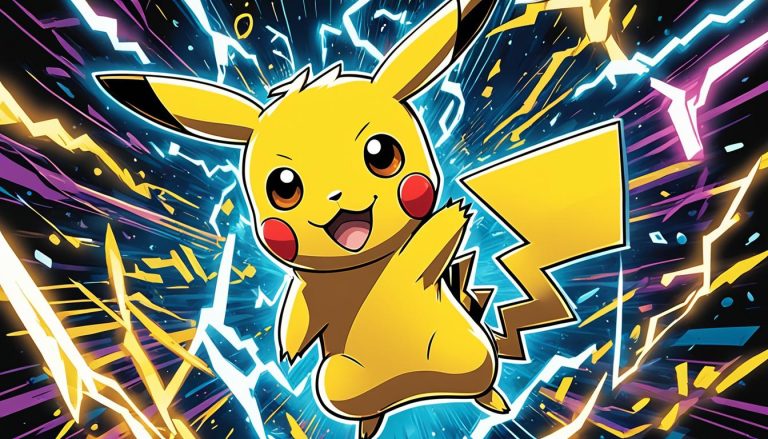How to Draw Dragon – Drawing Turorials and Coloring Tips
Have you ever wondered how to capture the majestic essence of dragons in your artwork? Whether you’re an aspiring artist or a seasoned pro, mastering the art of drawing dragons can be an exhilarating journey that unlocks your imagination and creativity. But where do you start? How do you bring these mythical creatures to life on paper?
In this comprehensive guide, we will provide you with step-by-step tutorials, drawing techniques, and coloring tips to help you create stunning dragon art. From the basics of dragon anatomy to advanced art tutorials, you’ll learn the secrets to unleashing the power of your dragon drawings. Get ready to embark on an adventure and master the art of capturing the essence of these legendary creatures.
Key Takeaways:
- Learn how to draw dragons from scratch with our beginner’s guide
- Follow our step-by-step dragon drawing tutorial to create realistic and dynamic dragon art
- Understand the anatomy of dragons and enhance your drawings with accurate details
- Explore different types of dragons and bring their unique characteristics to life on paper
- Discover advanced techniques for shading, coloring, and adding intricate details to your dragon art
Beginner’s Guide to Drawing Dragons
If you’re new to drawing dragons, this section will provide a simplified approach to get started. We’ll cover the basic steps, such as drawing the head, body, limbs, and wings. By following these steps, you’ll be able to create your own dragon drawings with ease.
- Start with the head: Begin by sketching the basic shape of the dragon’s head. Pay attention to the placement of the eyes, nose, and mouth to give your dragon a unique expression.
- Outline the body: Once you have the head in place, extend the body lines to create the shape of the dragon. Consider the length and thickness of the body, as well as any scales or ridges you want to incorporate.
- Add the limbs: Dragons typically have four limbs, so draw the arms and legs according to the pose you want your dragon to be in. Remember to include claws or talons for added detail.
- Sketch the wings: Dragons are often depicted with large, powerful wings. Use curved lines to represent the shape of the wings, and don’t forget to add the smaller details like veins or membranes.
Once you have the basic structure of your dragon in place, you can start adding more details and refining your drawing. Experiment with different textures, patterns, and scales to make your dragon come to life.
Remember, drawing dragons is all about letting your imagination soar. Don’t be afraid to be creative and add your own personal touch to your drawings. With practice and patience, you’ll soon master the art of drawing magnificent dragons.
Step-by-Step Dragon Drawing Tutorial
Are you ready to bring a magnificent dragon to life on your canvas? In this section, we’ll guide you through a detailed step-by-step dragon drawing tutorial. Whether you’re an aspiring artist or just looking to explore your creativity, our tutorial will help you create a stunning dragon drawing.
Materials You’ll Need
- Pencil
- Eraser
- Drawing paper
Let’s Get Started!
Step 1: Begin by sketching the basic shapes of the dragon. Start with a large oval for the body and add a circle for the head. Connect the head to the body with a curved line. Don’t worry about details just yet, we’ll add them later.
Step 2: Now, let’s add the wings. Draw two curved lines extending from the shoulders of the dragon. Make sure to leave enough space for the arms and hands.
Step 3: It’s time to define the dragon’s face. Add the eyes, nose, and mouth. Use small, curved lines and circles to create the details. Don’t forget to give your dragon some fierce-looking teeth!
Step 4: Next, let’s work on the dragon’s limbs. Sketch the arms and hands, followed by the legs and feet. Pay attention to the positioning and proportion of each limb.
Step 5: Now that the basic structure of the dragon is in place, it’s time to add details. Start by adding scales to the body, wings, and limbs. Use small, overlapping lines to create the texture of the scales.
Step 6: Add the final touches to your dragon drawing. Define the shape and texture of the wings, and add any additional details, such as spikes or horns. Erase any unnecessary guidelines and smoothen out the lines.
Step 7: Congratulations! You’ve successfully completed your dragon drawing. Now, it’s time to bring it to life with colors. Grab your favorite coloring tools and let your imagination soar as you add vibrant hues to your dragon masterpiece!
Remember, practice makes perfect. Don’t be afraid to experiment with different styles and techniques. The more you draw, the better you’ll become at creating captivating dragon artwork.
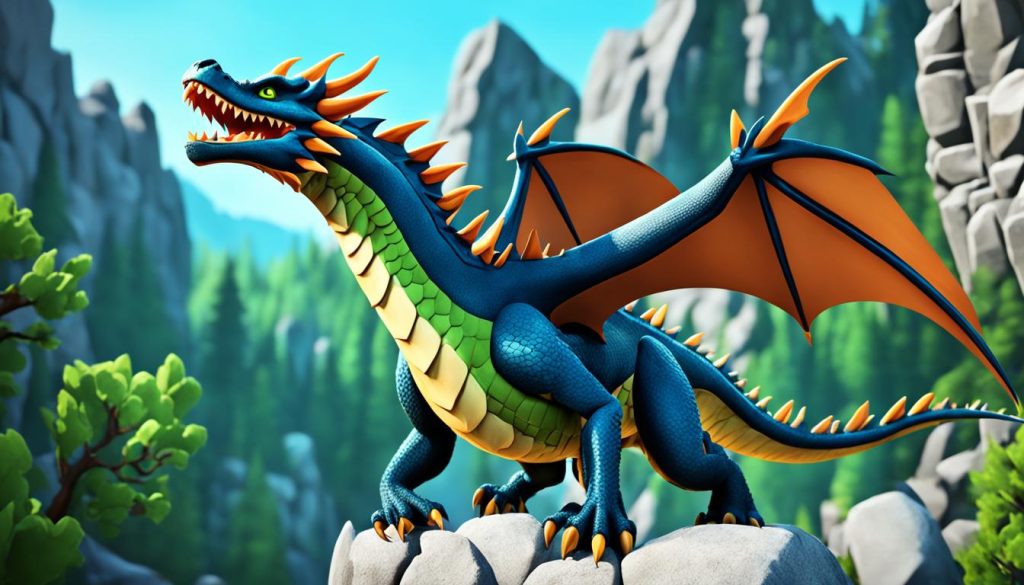
Now that you’ve mastered the step-by-step dragon drawing tutorial, you’re one step closer to becoming a true dragon artist. In the next section, we’ll explore the fascinating anatomy of dragons and how it can enhance your dragon artwork. Get ready to dive deeper into the world of dragon art!
Exploring Dragon Anatomy for Artists
Understanding the anatomy of a dragon is crucial for creating realistic and dynamic drawings. In this section, we’ll delve into the different anatomical features of dragons, such as their heads, wings, and tails. By studying their anatomy, you’ll be able to accurately depict dragons in your artwork.
The Head
The head of a dragon is one of its most distinctive features. It typically has a long snout, sharp teeth, and large, expressive eyes. Pay close attention to the placement and proportions of these features to capture the fierce and majestic nature of dragons. Don’t forget to include the intricate details of the scales on the head, as they add depth and texture to your drawings.
The Wings
The wings of a dragon are essential for creating a sense of power and majesty. They are typically large and membranous, similar to bat wings. Take note of the underlying structure of the wings, with multiple layers of bones and muscles, to ensure accuracy in your drawings. Experiment with different poses and positions of the wings to convey a sense of flight or aggression.
The Tail
The tail of a dragon is another striking feature that adds balance and movement to your drawings. It can be long and serpentine or thick and muscular, depending on the type of dragon you’re drawing. Pay attention to the texture and pattern of the scales on the tail, as well as any spikes or fins that may be present.
An Example of Dragon Anatomy
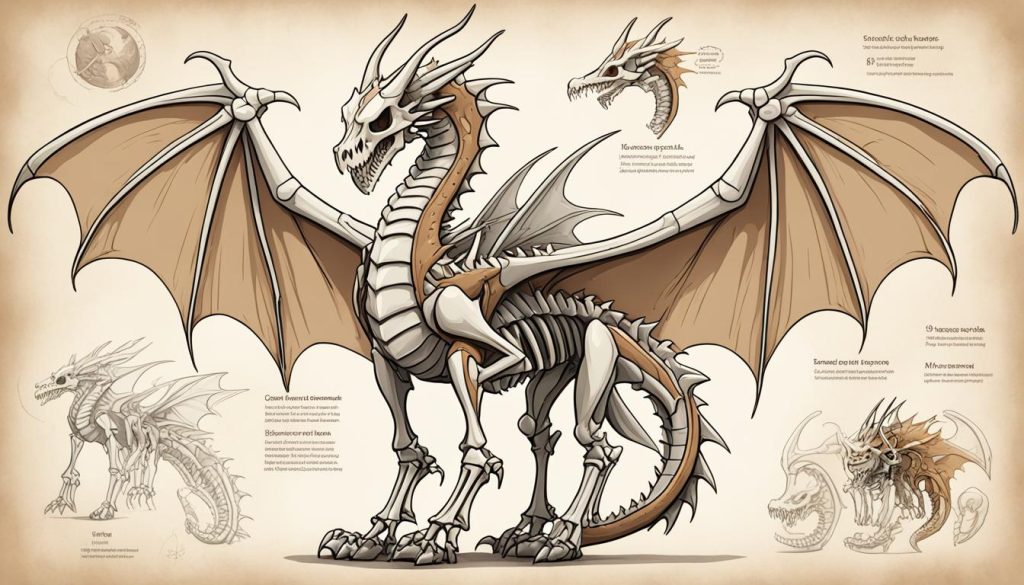
Capturing the intricate details of dragon anatomy can be challenging, but with practice and observation, you can create stunning and lifelike dragon drawings. Here’s an example table that showcases the different anatomical features of a dragon:
| Anatomical Feature | Description |
|---|---|
| Head | Long snout, sharp teeth, expressive eyes |
| Wings | Large and membranous, similar to bat wings |
| Tail | Long and serpentine or thick and muscular |
| Scales | Texture and pattern vary, adding depth to the drawing |
| Spikes/Fins | Optional features that can be present on the head, back, and tail |
By referring to this table, you can ensure that you include all the important anatomical features of a dragon in your drawings. Remember, mastering dragon anatomy takes time and practice, so don’t be afraid to experiment and let your creativity soar!
Advanced Dragon Art Tutorials
Ready to take your dragon drawing skills to the next level? This section provides a collection of advanced art tutorials that will elevate your dragon artwork to new heights. Whether you’re an experienced artist looking to refine your techniques or an aspiring artist seeking inspiration, these tutorials have got you covered.
Shading Techniques for Realistic Dragons
Learn how to master the art of shading to add depth and dimension to your dragon drawings. From creating realistic textures to capturing light and shadow, these tutorials will guide you through various shading techniques. Perfect your skills and bring your dragons to life on paper.
| Shading Techniques | Description |
|---|---|
| Contour Shading | Create realistic contours and define the form of your dragon with this technique. |
| Hatching and Crosshatching | Add texture and detail to your dragon’s scales, skin, and other elements using hatching and crosshatching. |
| Gradation Shading | Master the art of smooth transitions between light and shadow with gradation shading. |
Enhancing Details and Textures
Take your dragon drawings to the next level by mastering the art of intricate details and textures. These tutorials will teach you various techniques to add depth and realism to your dragons, from rendering scales and feathers to creating stunning dragon eyes.
| Detail and Texture Techniques | Description |
|---|---|
| Scale Rendering | Learn how to render intricate scales to give your dragons a realistic and captivating appearance. |
| Feather Detailing | Add texture and lifelike qualities to your dragon’s wings with detailed feathering techniques. |
| Creating Expressive Eyes | Master the art of drawing mesmerizing and expressive eyes that bring your dragons to life. |
Inspiring Dragon Artwork
Feeling inspired? Explore a showcase of breathtaking dragon artworks created by talented artists around the world. These stunning illustrations will ignite your imagination and provide a wealth of inspiration for your own dragon drawings.
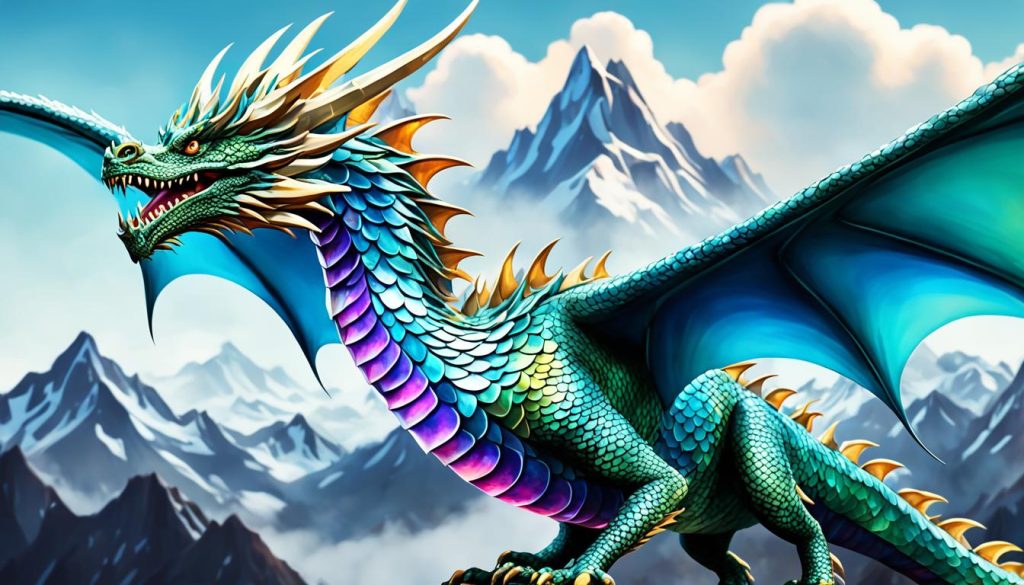
“Dragons are the embodiment of power, beauty, and mythical wonder. Let these incredible artworks fuel your creativity and push the boundaries of your own dragon art.”
With these advanced tutorials and a plethora of mesmerizing dragon artwork at your fingertips, you’re equipped to create stunning dragon drawings that showcase your unique artistic style. Let your imagination soar as you master advanced drawing techniques and bring captivating dragons to life on the page.
Mastering Dragon Coloring Techniques
Coloring dragons can be just as exciting as drawing them. It’s the perfect opportunity to bring your dragon drawings to life with vibrant and captivating colors. In this section, we’ll share some valuable tips and techniques for coloring dragons that will help you create stunning and dynamic artwork.
Choosing the Right Color Palette
When it comes to coloring dragons, selecting the right color palette is essential. Consider the mood and personality you want your dragon to portray. For fierce and powerful dragons, bold and contrasting colors can work well. On the other hand, softer and more elegant dragons may benefit from a more subtle and harmonious color scheme.
Experiment with different color combinations to find what works best for your dragon. Don’t be afraid to get creative and try unconventional color palettes. After all, dragons are mythical creatures, and your imagination is the limit.
Adding Highlights and Shadows
Highlights and shadows bring depth and dimension to your dragon drawings. By strategically placing light and dark areas, you can make your dragons appear more realistic and three-dimensional.
When adding highlights, imagine the light source and determine where it would hit the dragon’s body. Typically, the top surfaces of the dragon, such as its snout, forehead, and top of the wings, will catch the most light. On the other hand, shadows form in areas that are blocked from the light source, such as the underside of the dragon’s body and wings.
Remember to blend and soften the transitions between highlights and shadows to achieve a more natural and realistic look.
Playing with Textures
Textures can enhance the visual appeal of your dragon drawings. From rough scales to smooth skin, experimenting with different textures can make your dragons feel more tactile and lifelike.
Use shading techniques to create the illusion of texture. For example, cross-hatching can mimic the appearance of scales, while gentle strokes can represent smoother areas. Observing reference images or studying real-life reptiles can provide valuable insights into different textures that you can translate onto your dragon artwork.
To illustrate the techniques mentioned, below is an example of a colored dragon:
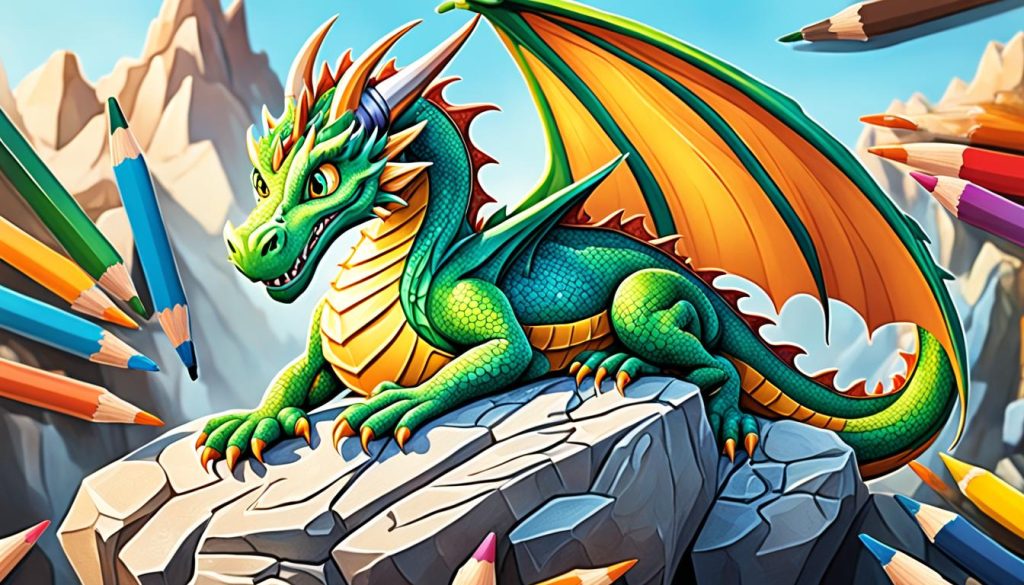
| Color Palette: | Highlights: | Shadows: | Texture: |
|---|---|---|---|
| Rich reds, deep blues, and vibrant greens | Bright gold tones on scales, snout, and horns | Dark purples and blues on underside and crevices | Cross-hatched scales with smooth skin in-between |
Feel free to use this color palette, highlight and shadow placement, and texture techniques as a starting point for your dragon coloring adventures. As you become more experienced, don’t shy away from experimenting and developing your unique style.
Drawing Different Types of Dragons
Dragons have captured our imagination for centuries, and they come in various shapes and forms. In this section, we’ll explore different types of dragons, ranging from Western-style dragons to Eastern-style dragons and even mythical dragons.
Each type of dragon carries its own unique characteristics and features, making them captivating subjects for artists to bring to life on paper. Here, we’ll provide insights into the distinct traits of these dragon species and guide you in drawing them with precision.
Let’s dive into the fascinating world of different dragon types:
1. Western-Style Dragons
Western-style dragons, often depicted in European folklore, are known for their majestic appearance and large wingspan. These dragons typically have four legs, a long serpentine body, and prominent horns or crests on their heads. They are often associated with power and strength.
To capture the essence of a Western-style dragon, focus on defining its muscular physique, intricate details like scales, and the grandeur of its wings. Pay attention to the positioning of the dragon’s wings, as they play a vital role in conveying its presence and movement.
2. Eastern-Style Dragons
Eastern-style dragons, prevalent in East Asian cultures like Chinese and Japanese mythology, have a more serpentine and elongated body. These dragons are often depicted as benevolent, wise creatures associated with good fortune and rain. Unlike Western-style dragons, they are commonly portrayed without wings.
To capture the elegance of an Eastern-style dragon, focus on fluid lines and curves when sketching its body. Emphasize the intricate details of its scales, long whiskers, and expressive eyes. Adding clouds or water beneath the dragon can enhance the overall composition and convey a sense of movement.
3. Mythical Dragons
Mythical dragons encompass a wide range of fantastical creatures from various mythologies and folklore around the world. These dragons may have multiple heads, elemental powers, or unique characteristics that set them apart from traditional Western or Eastern dragons.
When drawing a mythical dragon, let your imagination run wild. Experiment with unconventional shapes, patterns, and extravagant details. Consider incorporating elements representative of its mythology, such as fire, ice, or natural landscapes, to bring out the essence of the mythical creature.
Remember, the key to successfully drawing different types of dragons lies in understanding their unique characteristics and incorporating those details into your artwork. Embrace your creative freedom, experiment with various styles, and have fun exploring the fascinating world of dragons.

| Dragon Type | Characteristics |
|---|---|
| Western-Style Dragons | Four legs, long serpentine body, large wingspan, horns or crests |
| Eastern-Style Dragons | Serpentine body, elongated, commonly portrayed without wings |
| Mythical Dragons | Varies depending on mythology, multiple heads, elemental powers, unique characteristics |
Tips for Illustrating Dragons in Card Games
Dragons have always been captivating creatures in the world of card games and illustrations. To bring these magnificent beasts to life in your card game projects, we have curated a set of helpful tips and techniques specifically tailored for illustrating dragons. Whether you are a seasoned artist or just starting out, these insights will guide you in creating captivating dragon illustrations that will leave your audience spellbound.
1. Creating Dynamic Poses
Dragons are known for their powerful presence and majestic movements. To capture their essence, experiment with dynamic poses that convey their strength and agility. Whether it’s a dragon in mid-flight, perched on a mountaintop, or engaged in battle, these poses will add a sense of excitement and energy to your illustrations.
2. Conveying Emotions
Dragons possess a wide range of emotions, from ferocious anger to serene tranquility. When illustrating dragons, consider the emotions you want to evoke in your audience. Are you aiming for a fearsome and intimidating dragon or a wise and benevolent one? Pay attention to their facial expressions, body language, and the use of color to effectively convey the desired emotions.
3. Mastering Scale and Proportions
Dragons come in all shapes and sizes, so it’s important to master the art of scale and proportions. Pay attention to the relative size of different body parts such as the head, wings, and tail. Use reference images or study the anatomy of real-world creatures to ensure a sense of believability in your dragon illustrations.
4. Utilizing Light and Shadow
Light and shadow play a crucial role in creating depth and dimension in your dragon illustrations. Experiment with different lighting scenarios to give your dragons a three-dimensional appearance. Understand how light interacts with their scales, wings, and other features to add realism and enhance the overall impact of your artwork.
5. Detailing Scales, Textures, and Features
Dragon scales, intricate textures, and unique features like horns, spikes, and claws are what make them visually captivating. Take the time to meticulously detail these elements. Use cross-hatching, stippling, or other shading techniques to create depth and add visual interest to their physiology. Remember to strike a balance between intricate details and overall composition to avoid overwhelming your illustrations.
6. Exploring Color Palettes
The choice of color palette can greatly influence the mood and atmosphere of your dragon illustrations. Experiment with different color schemes to evoke various emotions. Vibrant hues may portray a fiery and fierce dragon, while cool tones might convey a more serene and mystical presence. Don’t be afraid to explore unexpected color combinations to create unique and captivating visuals.
7. Studying Real and Mythical Inspiration
When illustrating dragons, draw inspiration from a variety of sources. Study real-life reptiles, birds, and other creatures to add realism to your dragon’s anatomy and movements. Delve into myths, legends, and folklore to capture the essence of mythical dragons. Combining both real and mythical inspiration will give your dragon illustrations a rich and enchanting quality.
Remember, illustrating dragons is a journey of imagination and creativity. Embrace experimentation, learn from the masters, and always stay inspired. Let your dragons take flight and transport your audience to a world filled with wonder and awe.
Now, let’s delve into the key elements to keep in mind when illustrating dragons in card games. Incorporating these tips and techniques will help you create captivating and memorable dragon illustrations that will enhance the gaming experience for players.
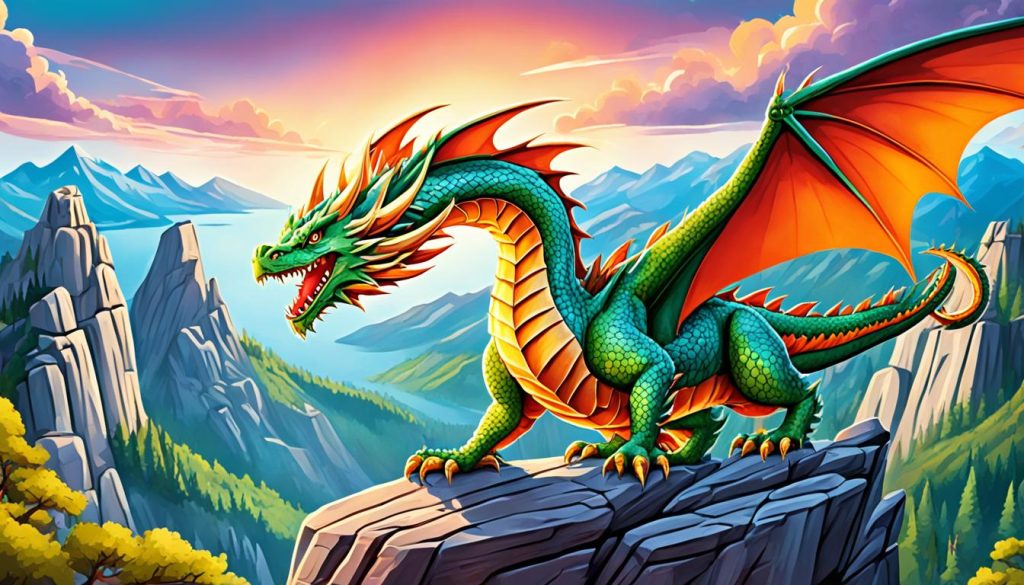
Enhancing Your Dragon Drawings with Digital Tools
To truly take your dragon drawings to the next level, digital tools can be a game-changer. With the help of digital art software, you can unlock a whole new realm of possibilities for enhancing your dragon artwork. In this section, we’ll provide you with an introduction to digital art software and share valuable tips on how to make your dragon drawings truly stand out.
One popular digital art software that many artists swear by is Adobe Photoshop. This powerful tool offers a wide range of features and capabilities that can greatly enhance your dragon drawings. From digital painting to adding special effects, Photoshop allows you to unleash your creativity and bring your dragons to life in a vibrant and captivating way.
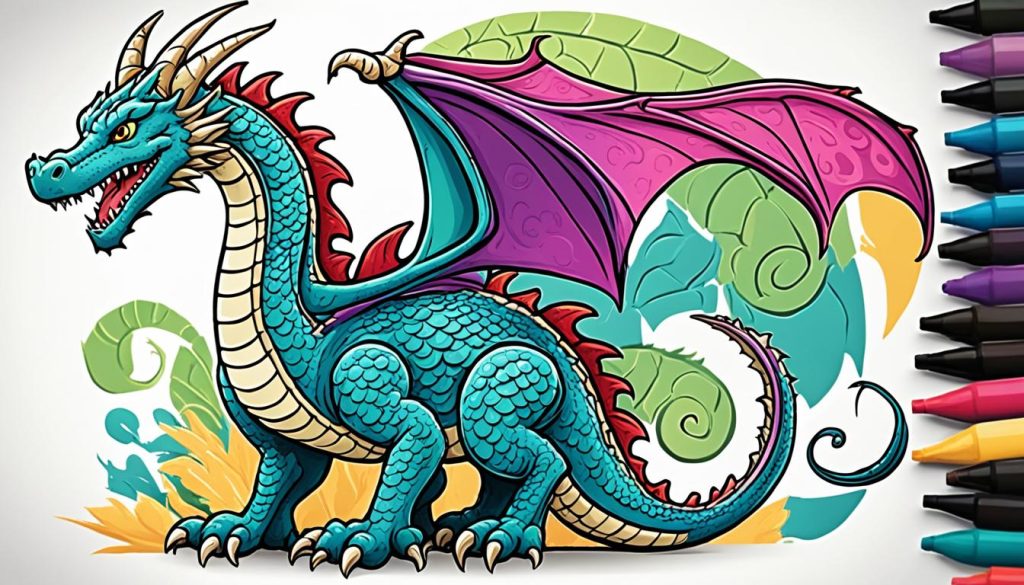
When utilizing digital tools, it’s important to have a solid understanding of digital painting techniques. The ability to create digital brush strokes and blend colors seamlessly is key to achieving stunning dragon artwork. Experiment with different brush sizes, opacity levels, and blending modes to find the perfect combination that brings out the essence of your dragon.
“Digital art is a powerful medium that opens up endless possibilities for expressing your creativity. With the right tools and skills, you can truly bring your dragon drawings to life.”
Layering is another essential technique in digital art. By working with different layers, you can easily make changes and adjustments without affecting the rest of your artwork. This flexibility allows you to experiment freely and iterate on your dragon drawings until they reach perfection.
In addition to digital painting and layering, don’t be afraid to explore the vast array of special effects that digital tools offer. Whether it’s adding a fiery glow to your dragon’s breath or creating a sense of movement in its wings, these effects can add depth and dynamism to your artwork. Just be mindful of not overusing effects and maintaining a balance that complements the overall composition.
Software Recommendations for Enhancing Dragon Drawings
Below are some popular digital art software options that can help you enhance your dragon drawings:
| Software | Description |
|---|---|
| Adobe Photoshop | A comprehensive digital art software with a wide range of features for painting, editing, and special effects. |
| Corel Painter | A powerful tool for digital painting that offers realistic brush strokes and an extensive collection of brushes. |
| Procreate | An intuitive and user-friendly app designed specifically for digital artists, available on iOS devices. |
Remember, the key to mastering digital tools lies in practice and experimentation. Take the time to explore different brushes, techniques, and effects to find your unique style and bring your dragons to life like never before.
Conclusion
Drawing dragons is a wonderful way to tap into your creativity and delve into the realms of fantasy. Throughout this article, we have provided you with a comprehensive guide on how to draw dragons, offering step-by-step tutorials, tips, and techniques. By following these guidelines, you’ll be equipped with the necessary knowledge to create stunning dragon artwork.
Remember, practice is key when it comes to honing your dragon drawing skills. Take the time to experiment with different styles, poses, and color palettes. Embrace the journey and allow yourself to make mistakes – it’s through these experiences that you’ll truly grow as an artist.
As you embark on your dragon drawing journey, we encourage you to have fun and let your imagination soar. Whether you’re a beginner or advanced artist, there are always new techniques to explore and new dragons waiting to be brought to life. So grab your pencil, unleash your creativity, and let the dragons on your canvas ignite a sense of wonder and awe.



